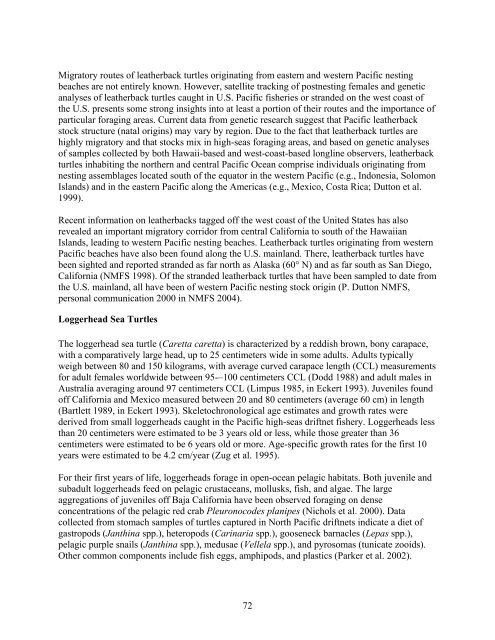Hawaii FEP - Western Pacific Fishery Council
Hawaii FEP - Western Pacific Fishery Council
Hawaii FEP - Western Pacific Fishery Council
Create successful ePaper yourself
Turn your PDF publications into a flip-book with our unique Google optimized e-Paper software.
Migratory routes of leatherback turtles originating from eastern and western <strong>Pacific</strong> nestingbeaches are not entirely known. However, satellite tracking of postnesting females and geneticanalyses of leatherback turtles caught in U.S. <strong>Pacific</strong> fisheries or stranded on the west coast ofthe U.S. presents some strong insights into at least a portion of their routes and the importance ofparticular foraging areas. Current data from genetic research suggest that <strong>Pacific</strong> leatherbackstock structure (natal origins) may vary by region. Due to the fact that leatherback turtles arehighly migratory and that stocks mix in high-seas foraging areas, and based on genetic analysesof samples collected by both <strong>Hawaii</strong>-based and west-coast-based longline observers, leatherbackturtles inhabiting the northern and central <strong>Pacific</strong> Ocean comprise individuals originating fromnesting assemblages located south of the equator in the western <strong>Pacific</strong> (e.g., Indonesia, SolomonIslands) and in the eastern <strong>Pacific</strong> along the Americas (e.g., Mexico, Costa Rica; Dutton et al.1999).Recent information on leatherbacks tagged off the west coast of the United States has alsorevealed an important migratory corridor from central California to south of the <strong>Hawaii</strong>anIslands, leading to western <strong>Pacific</strong> nesting beaches. Leatherback turtles originating from western<strong>Pacific</strong> beaches have also been found along the U.S. mainland. There, leatherback turtles havebeen sighted and reported stranded as far north as Alaska (60° N) and as far south as San Diego,California (NMFS 1998). Of the stranded leatherback turtles that have been sampled to date fromthe U.S. mainland, all have been of western <strong>Pacific</strong> nesting stock origin (P. Dutton NMFS,personal communication 2000 in NMFS 2004).Loggerhead Sea TurtlesThe loggerhead sea turtle (Caretta caretta) is characterized by a reddish brown, bony carapace,with a comparatively large head, up to 25 centimeters wide in some adults. Adults typicallyweigh between 80 and 150 kilograms, with average curved carapace length (CCL) measurementsfor adult females worldwide between 95-–100 centimeters CCL (Dodd 1988) and adult males inAustralia averaging around 97 centimeters CCL (Limpus 1985, in Eckert 1993). Juveniles foundoff California and Mexico measured between 20 and 80 centimeters (average 60 cm) in length(Bartlett 1989, in Eckert 1993). Skeletochronological age estimates and growth rates werederived from small loggerheads caught in the <strong>Pacific</strong> high-seas driftnet fishery. Loggerheads lessthan 20 centimeters were estimated to be 3 years old or less, while those greater than 36centimeters were estimated to be 6 years old or more. Age-specific growth rates for the first 10years were estimated to be 4.2 cm/year (Zug et al. 1995).For their first years of life, loggerheads forage in open-ocean pelagic habitats. Both juvenile andsubadult loggerheads feed on pelagic crustaceans, mollusks, fish, and algae. The largeaggregations of juveniles off Baja California have been observed foraging on denseconcentrations of the pelagic red crab Pleuronocodes planipes (Nichols et al. 2000). Datacollected from stomach samples of turtles captured in North <strong>Pacific</strong> driftnets indicate a diet ofgastropods (Janthina spp.), heteropods (Carinaria spp.), gooseneck barnacles (Lepas spp.),pelagic purple snails (Janthina spp.), medusae (Vellela spp.), and pyrosomas (tunicate zooids).Other common components include fish eggs, amphipods, and plastics (Parker et al. 2002).72












